Strategies for businesses to overcome sustainability challenges and thrive

The global temperature has surpassed 1.5°C throughout the entire year for the first time. This represents that businesses are struggling to uphold their strategies against sustainability challenges and face increased responsibilities to mitigate long-term impacts.
According to the IEA's projections, the global oil demand experienced a rise of 1.9 million barrels per day compared to the previous peak in 2022. As a result, carbon emissions from fossil fuels reached unprecedented levels.
A team of over 120 scientists at Global Carbon Project warned that if the world keeps emitting CO2 at this rate, it would deplete the remaining carbon budget to a 50% chance of limiting to 1.5°C (2.7°F) above pre-industrial levels within seven years.
Related: Carbon Neutral vs Net Zero
Impact, risks, and trends in 2023
Rising temperatures contribute to the escalation of climate change, as evidenced by recent extreme heatwaves, droughts, wildfires, and floods. Just by raising the limit from 1.5°C to 2°C significantly increases the risk of crossing critical tipping points, triggering potentially irreversible transformations.
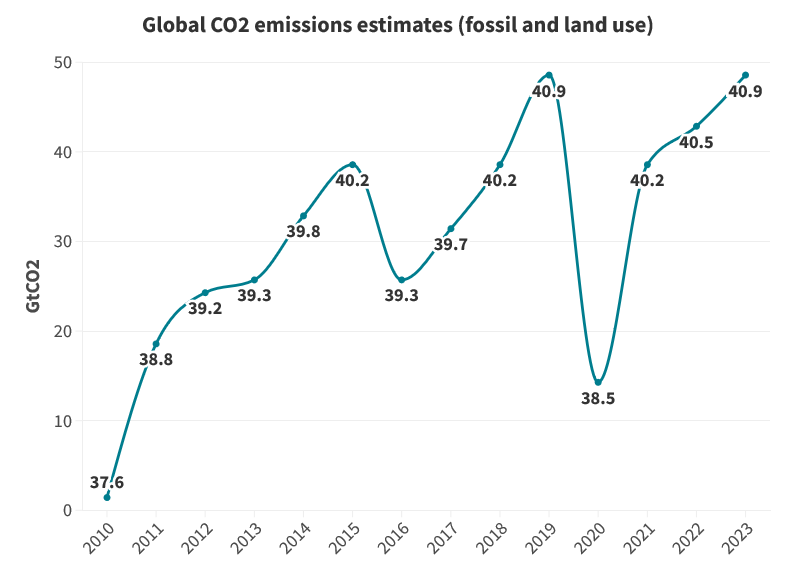
An international research report, Global Carbon Budget 2023, collaboratively produced by over 100 scientists estimated the total global CO2 emissions, considering both fossil fuels and land-use changes, reached 40.9 billion tonnes in 2023 (Figure 1).
Other findings included an estimated rise of 8.2% in India's global CO2 emissions and a 4% increase in China. The EU and the U.S. saw declines of 7.4% and 3%, respectively (Figure 2).
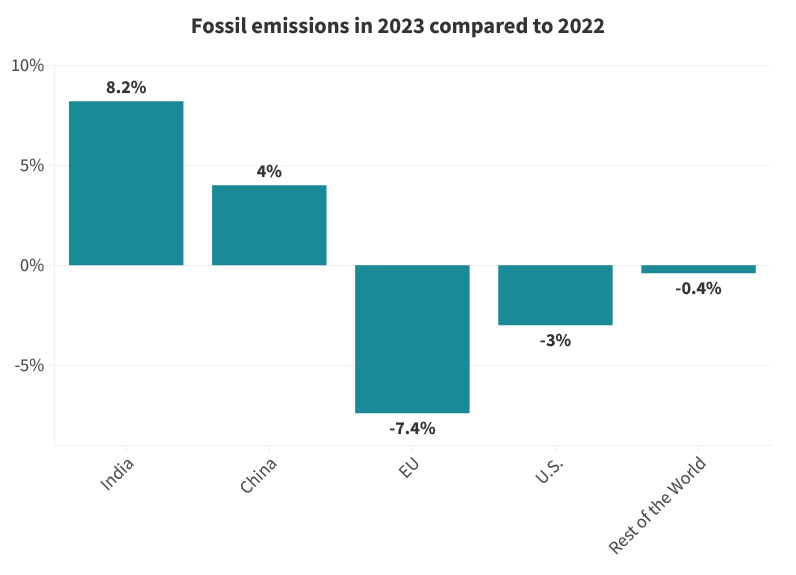
The fact is, the sustainability challenges lie in acknowledging the effects of the climate crisis, primarily coming from businesses eventually return to destruct their operations and policies.
What benefits the earth also benefits the business
Businesses primarily care about profit rather than saving the planet. However, many actions taken by companies to enhance sustainability also contribute to improved business efficiency—maximizing profitability.
This brings us to the crucial aspects of constructing a more sustainable organization. For this, leaders need to align sustainability goals with business objectives and integrate them into their operations.
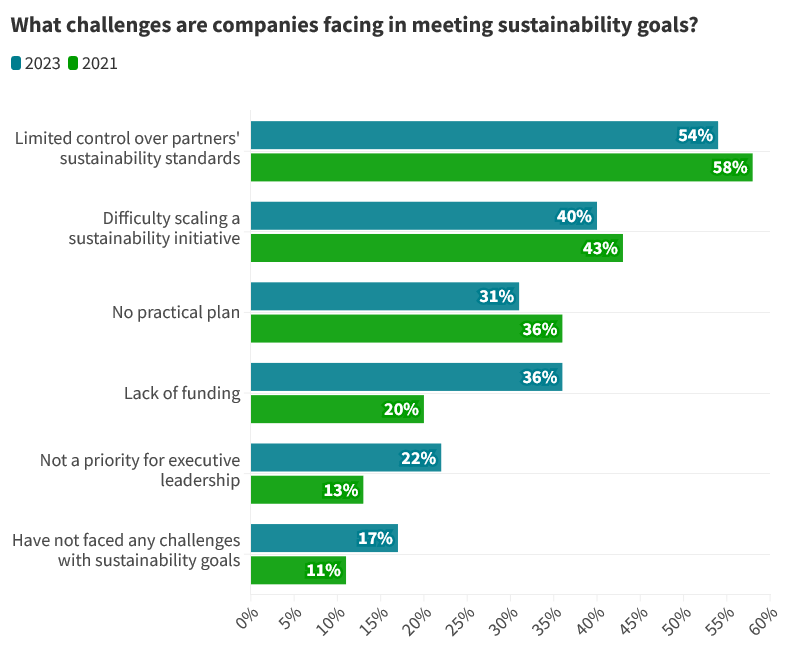
Forbes created a report, including an online survey conducted in 2021 and 2023, focusing on trends in the manufacturing industry (Figure 3). The survey targeted 241 senior decision-makers representing various sectors, including electronics, medical devices, automotive, industrial and robotics, aerospace, and energy.
The majority of leaders believed that their sustainability standards heavily rely on those of their partners and collaborators, which are often challenging to access. The percentage decreased from 58% in 2021 to 54% in 2023 but still remained relatively high.
The issue of "no practical plan" is also a significant challenge for companies. On this matter, many deliberate actions, such as the transition to clean energy, are perceived to be lagging.
The BCG's 2023 report revealed an $18 trillion gap between energy transition commitments and required investments through 2030 (Figure 4). This gap includes infrastructure, electricity, and end-use.
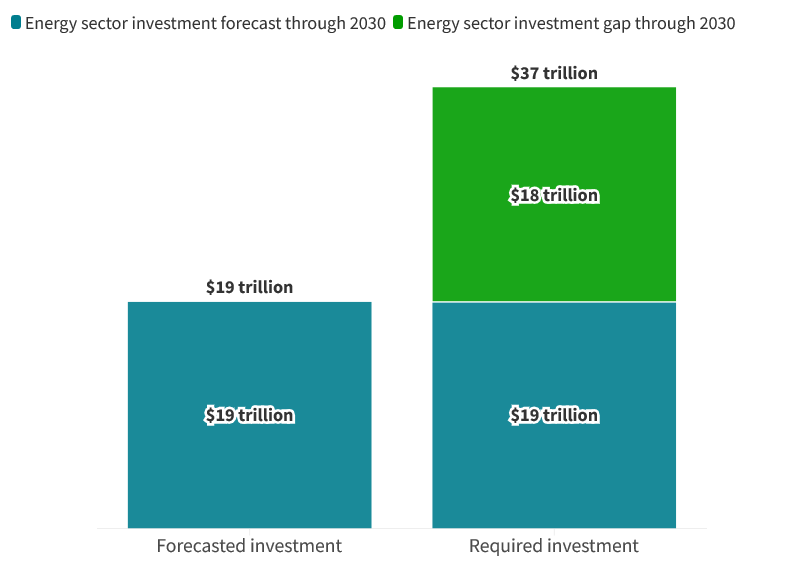
More than 80% of companies are facing sustainability challenges
Before COP28, Accenture surveyed over 1,000 executives from 14 industries and 16 countries to gain insights into the immediate challenges and priorities associated with industrial decarbonization.
Related: COP28: fossil fuels challenge wins while loss and damage encounter setback
The study revealed that less than one in five companies (18%) are presently on track to achieve net-zero by 2050 (Figure 5). Additionally, about 83% indicate their inability to face sustainability challenges.
These companies indicated difficulty in making further investments in decarbonization within the current economic climate. This includes 33% of the companies who are off track to meet net zero by 2050 but still decreasing some emissions.
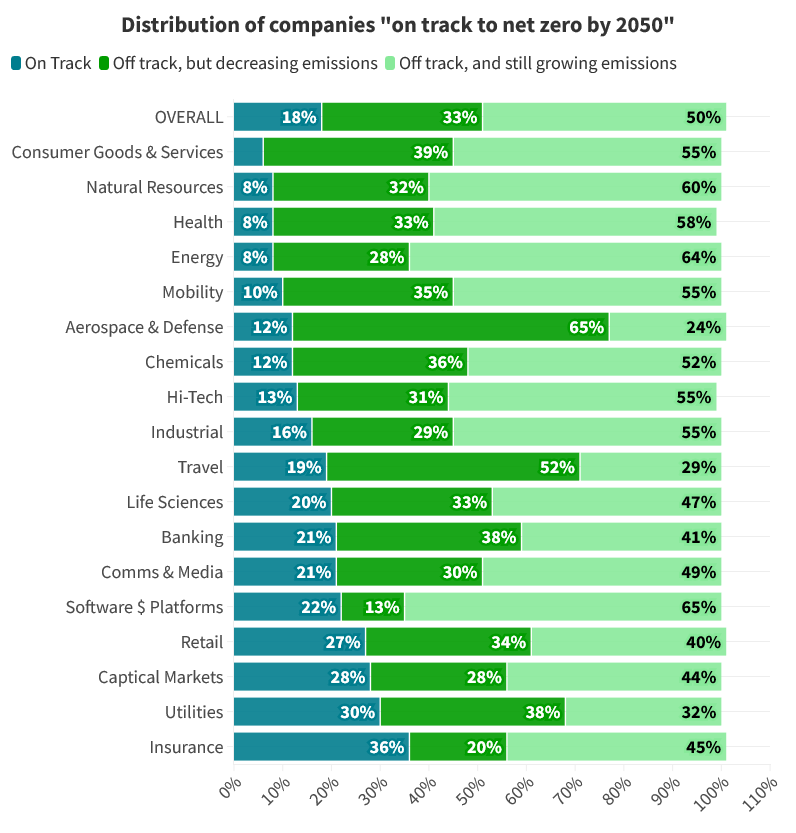
Despite this, the study suggests that industry leaders can rebound in three years by reimagining decarbonization strategies. This transformation could foster growth, especially for energy-intensive and challenging heavy industries like steel, metals, and mining. The industry is collectively responsible for generating 40% of total global CO2 emissions.
Jean-Marc Ollagnier, CEO of Accenture for Europe, Middle East, and Africa, remarked, "Achieving net zero presents a distinctive opportunity for each business to reshape themselves and their value chains, aligning business growth, despite the numerous hurdles they may face. Yet, this is a challenge of an ecosystem, needing better resolution and connection between supply and demand."
An effective sustainability plan relies on accurate information regarding carbon emissions and their impacts. Unfortunately, many companies lack a comprehensive understanding of the extent of their environmental footprint and the methods to measure it. Overcoming those challenges becomes nearly impossible when unaware of the problems and lacking the necessary infrastructure to gauge progress.
How does exceeding 1.5°C impact businesses?
- The IPCC has identified various risks, including hurricanes, wildfires, and a higher likelihood of extreme droughts. These weather events can have a significant impact on businesses, disrupting their supply chain, and leading to logistical challenges.
- Disruption in the supply chain automatically initiates material scarcity, particularly if businesses continue pursuing supplies without embracing sustainable practices or transitioning to renewable resources.
- Extreme weather conditions can also affect employees' ability to commute to work and deliver, either due to travel constraints or the need to take time off for housing repairs or relocation caused by fires, floods, and heat waves.
- As communities are disrupted leading to people being displaced due to increased flooding and droughts, customers suffer from financial constraints. This may result in reduced spending and shifts in demand for specific products and services— directly affecting the businesses.
Related: Carbon dioxide vs Carbon monoxide: how do they affect climate and health?
How companies can overcome sustainability challenges?
Jeff Perlman, the founder and CEO of Bright Power, a company specializing in energy and management services told Forbes that the buildings contribute to nearly 40% of global carbon emissions. This means that businesses will face increasing accountability for their physical spaces' carbon footprint.
Perlman believes that business owners will need to turn to technological solutions, such as real-time energy management, and on-site clean energy generation without fossil fuels, to actively manage and monitor energy usage and mitigate adverse environmental impacts.
For leaders to seamlessly incorporate sustainability into their values and practices, here are some points to include in the day-to-day operations of the organization.
- Evaluate climate risks linked to unsustainable alternatives and the potential for innovation through the incorporation of sustainable practices.
- Embrace a collaborative strategy by involving industry partners and stakeholders to exchange knowledge and resources.
- Incorporate circularity throughout a company via practices like repair and reuse.
- Enhance employee’s dedication to sustainability. Existing staff members play a vital role in driving change within companies.
- Prioritize efficiency by investing in clean energy transition.
- Conduct a thorough test on the supply chain to assess cost efficiency, carbon intensity, and resilience. By reassessing supplier relationships and identifying dependencies, it is possible to reduce costs and minimize risks.
Related: Renewable energy investments call for stronger commitment to net-zero initiatives
While there has been some progress in adopting green technologies, the challenges of climate change persist. However, this presents an opportunity for companies to embrace their climate-related goals, such as attaining carbon neutrality, promoting green energy conservation, and implementing carbon offset programs.
Related: Is investing in carbon credits a viable solution to meet climate targets?



